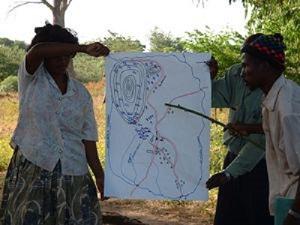Mophat Phiri
The overall aim of this project is to address the drastic decline of the bat populations in the Pumalanga gold mine abandoned caves where their habitats, roosts and caves are being destroyed and vandalised.

Some of the saved populations of threatened bats enjoying in the rehabiltated that were destroyed caves by communities
This project originated from the conservation research carried out by biodiversity conservation lecturers and students at the University of Pretoria in 1996 and in 2006. The results of the 1996 research indicate that there were 25 abandoned gold mine caves in the Mpumalanga region which used to support about 250,000 bats. However, the results of the recent study (2006) indicate that the number of bats in the same region has drastically declined to 18,000 and only 5 caves are still in habitable state.

Dr. Jasse conducting public lecture on importance of bats and rehabiliation of degraded mines shown on the map
It was observed that many habitats, roosts and caves had been destroyed and vandalised by setting them on fire and filling them up with small stones, rubbish and broken pieces of glass and wood (Stiles, Martin and Mayienda, 2006). One of the recommendations made to address this human-wildlife conflict was to task conservation bodies in South Africa to sensitise and educate local communities and stakeholders about the importance of bats.
This would help them to change peoples' bad mindset about bats. And it is strongly believed that once peoples' behaviour has been changed for the better then they can easily be integrated in the conservation of bats and the rehabilitation of their destroyed habitats. Bats in this area are being killed in large numbers everyday by local communities, kids and stakeholders because they are believed to transit rabies to people and their livestock, and are also believed to produce bad odour and noise. The project, therefore, wants to educate people about the ecological importance of bats and lure them to participate in the rehabilitation of their destroyed habitats, roosts and caves.